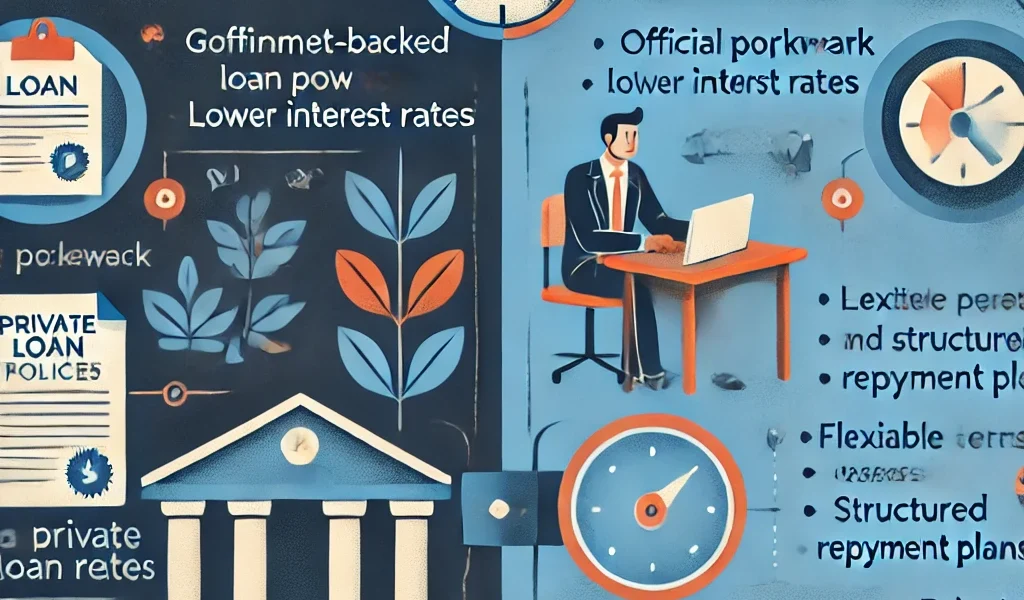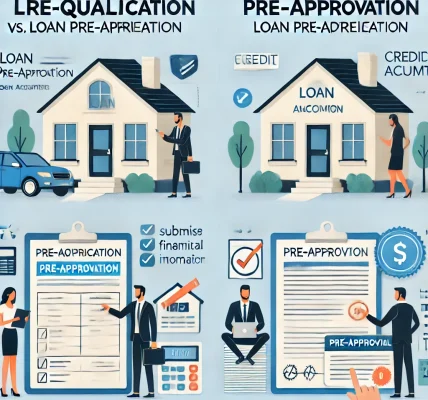Introduction
Loans are an essential financial tool that help individuals and businesses meet their financial goals. Borrowers have two primary options when seeking a loan: government-backed loans and private loans. Each type has distinct policies, eligibility criteria, benefits, and drawbacks. Understanding these differences is crucial for making an informed borrowing decision.
In this article, we will compare government loan policies with private loan policies, discussing their key differences, benefits, and which option is best suited for different needs.
1. Overview of Government and Private Loan Policies
Government Loan Policies
Government-backed loans are funded, insured, or guaranteed by federal, state, or local government bodies. These loans are typically designed to support individuals with lower income, small businesses, students, or homeowners who might not qualify for traditional loans.
Examples of Government Loans:
- Student loans (e.g., Federal Student Aid in the U.S.)
- Small Business Administration (SBA) loans
- Mortgage loans (e.g., FHA loans, VA loans)
- Agricultural loans for farmers
- Disaster relief loans
Private Loan Policies
Private loans are offered by commercial banks, credit unions, and online lenders. These loans are not backed by the government and are based on the borrower’s creditworthiness and financial profile.
Examples of Private Loans:
- Personal loans
- Private student loans
- Home loans from private banks
- Business loans from financial institutions
- Payday loans and short-term financing
2. Key Differences Between Government and Private Loans
| Feature | Government Loans | Private Loans |
|---|---|---|
| Interest Rates | Lower, fixed rates | Higher, may be fixed or variable |
| Eligibility | Based on income, need, or specific criteria | Based on credit score and income stability |
| Loan Amount | Limited by government regulations | Determined by lender, often higher limits |
| Approval Process | Longer due to strict requirements | Faster approval times |
| Repayment Options | Flexible repayment, deferment, and forgiveness programs | Standard repayment plans with limited flexibility |
| Collateral Requirement | Often not required | May require collateral for secured loans |
| Government Backing | Guaranteed by the government | No government backing |
3. Interest Rates and Repayment Terms
Government Loans
- Usually have lower, fixed interest rates to make borrowing affordable.
- Longer repayment periods (e.g., student loans can have up to 30 years for repayment).
- Offer deferment and forbearance options for financial hardship.
- Some loans, like student loans, may offer loan forgiveness programs.
Private Loans
- Higher interest rates due to market-based pricing and lender risk assessment.
- Shorter repayment terms, typically between 2 to 10 years for personal loans.
- Limited options for deferment or forgiveness.
- May allow refinancing for lower interest rates.
4. Eligibility Criteria and Approval Process
Government Loans
- Designed for individuals with financial need, lower income, or special status (e.g., veterans, students, small business owners).
- Often require extensive documentation and proof of eligibility.
- Longer approval process due to regulatory requirements.
- Credit scores may not be a significant factor (e.g., some student loans don’t require credit history).
Private Loans
- Based primarily on credit score, income stability, and debt-to-income ratio.
- Faster approval process, sometimes within 24 hours.
- Requires fewer documents but may have strict lending criteria.
- Higher credit scores increase approval chances and secure better interest rates.
5. Flexibility and Loan Amount
Government Loans
- Loan amounts are often limited by policy (e.g., student loans have annual limits).
- Can only be used for specific purposes (education, home purchase, business expansion, etc.).
- Offer flexible repayment plans based on income level.
Private Loans
- Borrowers can request higher loan amounts depending on creditworthiness.
- Funds can be used for multiple purposes, including medical expenses, home renovations, debt consolidation, etc.
- Standard repayment schedules with limited customization.
6. Risks and Benefits of Government and Private Loans
Government Loans
✅ Pros:
- Lower interest rates
- Flexible repayment options
- Forgiveness and deferment programs available
- Easier access for borrowers with lower credit scores
❌ Cons:
- Limited loan amounts
- Lengthy application and approval process
- Strict usage restrictions
Private Loans
✅ Pros:
- Faster approval and disbursal
- Higher borrowing limits
- No restrictions on loan usage
❌ Cons:
- Higher interest rates
- Fewer flexible repayment options
- Strict credit and income requirements
7. Which Loan Type is Right for You?
Choose a Government Loan if:
- You have a low credit score and need a lower interest rate.
- You need financial aid for education, housing, or small business growth.
- You require flexible repayment and possible loan forgiveness options.
Choose a Private Loan if:
- You need quick access to funds with fewer restrictions on usage.
- You have a high credit score and can secure better interest rates.
- You require a higher loan amount than government loans offer.
Conclusion
Both government and private loans serve different financial needs. Government loans provide lower interest rates and borrower-friendly policies, making them ideal for education, home buying, and small businesses. However, they come with limitations and a slower approval process. On the other hand, private loans offer flexibility, faster approvals, and higher loan amounts but at a higher cost.
Choosing between the two depends on your financial situation, urgency, and repayment ability. Always compare interest rates, eligibility criteria, and repayment terms before making a borrowing decision.



